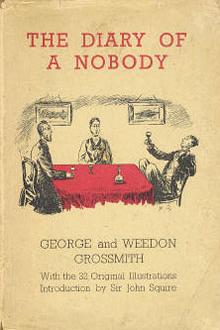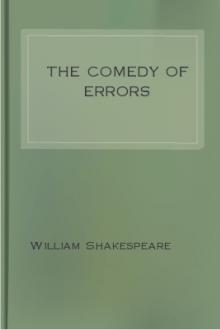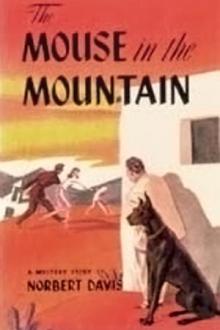The Confessions of a Caricaturist, Vol. 1, Harry Furniss [digital book reader txt] 📗

- Author: Harry Furniss
Book online «The Confessions of a Caricaturist, Vol. 1, Harry Furniss [digital book reader txt] 📗». Author Harry Furniss
The famous collars I "invented" for grotesque effect, but I always saw Mr. Gladstone without them, for to me his head has [Pg 164] never been, as some suppose, a mere block around which to wreathe a fantastic and exaggerated collar.
"I am told a Japanese artist who wishes to study a particular flower, for instance, travels to the part of the country where it is to be found; he takes no photographic camera, no superb sketching pad or box of paints, but he lives by the plant, watches day by day the flower grow, blossom, and decay, under every condition, and mentally notes every detail, so that ever afterwards he can paint that flower in every possible way with facility and knowledge. I have myself treated Mr. Gladstone as that Japanese artist treats the beautiful flower. I have frequently sat for many many hours watching every gesture, every change of expression. I have watched the colour leave his cheeks, and the hair his head; I have marked time contract his mouth, and have noted the development of each additional wrinkle. I have mused under the shade of his collars, and wondered at the cut of his clothes, sketched his three hats and his historical umbrella. More than that; during a great speech I have seen the flower in his button-hole fade under his flow of eloquence, seen the bow of his tie travel round to the back of his neck."
Thus I spoke night after night from the platform, and the laugh always came with the collars. It was not as a serious critic that I was posing before the audience, so I could fittingly describe the collars rather than the man. But when I had left the platform and the limelight, and my caricatures, I have had many a chat with Mr. Gladstone's admirers, with regard to the light in which I saw the great man without his collars, and this fact I will put forward as my excuse for publishing in my "Confessions" a few studies that I have made from time to time of the Grand Old Man, as an antidote not only to my own caricatures, but to the mass of Gladstone portraits published, which, with very few exceptions, are idealised, perfunctory, stereotyped, and worthless.
[Pg 165]
 MR. GLADSTONE.
MR. GLADSTONE."I have seen the flower in his buttonhole fade under his flow of eloquence."
Engraved on wood from an original study.
[Pg 166]
[Pg 167]
Generations to come will not take their impressions of this great man's appearance from these unsatisfactory canvases, or from the cuts in old-fashioned illustrated papers, in which all public men are drawn in a purely conventional tailor's advertisement fashion, with perfect-fitting coats, trousers without a crease, faces of wax, and figures of the fashionable fop of the period. The camera killed all this. But the photographer, although he cannot alter the cut of the clothes, can alter, and does alter, everything else. He touches up the face beyond recognition, and the pose is the pose the sitter takes before the camera, and probably quite different from his usual attitude. So it will be the caricatures, or, to be correct, the character sketches, that will leave the best impressions of Mr. Gladstone's extraordinary individuality.
 MR. GLADSTONE—CONVENTIONAL PORTRAIT.
MR. GLADSTONE—CONVENTIONAL PORTRAIT.
I heard Mr. Gladstone express his own views on portraiture one evening at a small dinner-party. My host of that evening had hit on the happy idea of having portraits of the celebrities of the age painted for him by a rising young artist. It was curious to note Mr. Gladstone as he examined these portraits. His manner was a strange comment on the political changes which had taken place, for as he came to the portraits of those of his old supporters who no longer fought under his colours, he would pass them by as though he had not seen them, or if his attention were called to any of them he would seem not to recognise the likeness, and pass on till his eye lighted on some political ally still numbered among the faithful, when he would at once pronounce the portrait excellent, and dwell upon its merits with apparent delight. A portrait of Mr. Labouchere, however, he generally failed to recognise. The portrait represented the Member for Northampton in a contemplative mood, certainly not characteristic of his habitual demeanour in the House.
[Pg 168]
"I have found," said he, "the artist I have been looking for for years. I have found an artist who can paint my portrait in four hours and a half; he has painted three in thirteen hours; that is Millais."
I was much surprised by this curious criticism on portrait painting. Surely, if the portrait of the great orator is to be painted in four hours and a half, the same limitation, if carried out, would confine the greatest speech ever made to a period of four-and-a-half seconds!
Someone pointedly asked Mr. Gladstone whether he liked Millais' portraits.
"Well," he replied, evading any brutal directness of reply, "I have been very much interested with his energy; he is the hardest-working man I ever saw."
"Do you prefer his result to Holl's?"
"Ah, Holl took double the time, and put me in such a very strained position, nearly on tiptoe. I know my heels were off the ground; it tired me out, and I was really obliged to lie down and sleep afterwards."
"You found Millais charming in conversation?"
"He never spoke when at work; his interest in his work fascinated me."
"Mr. Watts?"
"Ah, there is a delightful conversationalist, and a wonderful artist; he has attempted my portrait often—three attempts of late years—but he has not satisfied himself, and I am bound to say that my friends are of the same mind."
"I well remember," remarked Lord Granville, who was one of the party, "how uneasy poor Holl was before he painted your portrait. He came to me and said, 'I think if you would speak to Mr. Gladstone on some subject that would interest him, I would watch him, and that would aid me very much.'"
In this picture of Mr. Gladstone the late Frank Holl failed to maintain his reputation as an artist of the highest class: that picture of the great Liberal leader was disappointing and altogether unworthy of his name. This was the more unfortunate because, by the exercise of a little forethought, the artist [Pg 169] might easily have avoided that pitfall of portrait-painters, an awkward, constrained, and unaccustomed attitude, which Mr. Gladstone confessed was torturing him, and by a very simple expedient have succeeded in placing Mr. Gladstone in the position which everyone who has seen him in the act of delivering a speech in the House of Commons would have recognised at once as a true and characteristic pose.
Here I have mentioned Mr. Gladstone himself, saying how uncomfortable he felt upon the occasion of Mr. Holl's visit to his house for the purpose of obtaining a sitting; but I should add that the genial artist who was to do the work informed me that he also was no less ill at ease. When Mr. Gladstone enquired how he should sit for the portrait, Mr. Holl, anxious no doubt to secure a natural pose, replied, "Oh, just as you like!" This appeared to disconcert the great statesman somewhat, and he appeared to be ruminating as to what sedentary attitude was really his favourite one, when Holl came to the rescue.
 CARICATURE OF THE HOLL PORTRAIT.
CARICATURE OF THE HOLL PORTRAIT.
"I happened," said Mr. Gladstone, "to be standing at my library table with my hands upon a book, when Mr. Holl said, 'That will do, Mr. Gladstone, exactly,' and the result was that he painted me in that position. But I felt uncommonly awkward and uncomfortable the whole time, and as I have just said, I had to lie down and sleep after each sitting."
Now why was this? It was the very attitude of all others with which we who have studied it so often when the ex-Premier has been standing at the table in the House are so familiar. No artist who had once seen him in that position would have failed to select it as the most favourable and characteristic for the purposes of a historical portrait. And yet the picture, when it was completed, was a failure, and the artist himself knew that it was. The explanation is, I think, very simple, and it exemplifies once more the truth of the formula which defines genius to be "an infinite capacity for taking pains." Frank [Pg 170] Holl undoubtedly had talent, but his omission of an important detail in this picture—a detail which would have probably made all the difference between success and failure—shows once more by how narrow a line the highest art is often divided from the next best, that art of which we have such a plethora nowadays—which just contrives to miss hitting the bullseye of perfection.
When Mr. Holl exclaimed, "That will do, Mr. Gladstone, exactly," he was no doubt impressed with the idea that the great orator was more at ease standing at the table in the House of Commons than in any other position, and he therefore selected it for his picture. But he forgot that upon the table in the House there stands a box on which Mr. Gladstone was always in the habit, when he was speaking, of resting one of his hands, and that if that box was missing he would naturally, although perhaps unconsciously, be sensible that something to which he was accustomed was absent, and that he would therefore be as uncomfortable as a fish out of water. This was actually the case. But if some substitute for the box, of the proper height and size, had been forthcoming, I have not the slightest doubt, from my long and close observation of the habits and movements of Mr. Gladstone in the House, that he would at once have dropped easily into his customary attitude, and that the picture in the hands of so true an artist as Holl would then have been a conspicuous success.
Mr. Gladstone was asked whether he thought the tone of the House had degenerated in recent times. He replied that he did not think so at all, quoting in proof that after the introduction of the first Reform Bill many Members used to express their feelings in cock-crows and other offensive ways. Mr. Gladstone, however, at the time I met him, was getting decidedly deaf, and no doubt much that went on behind him in the House "did not reach" him.
Asked if the "count out" ought to be abolished, Mr. Gladstone said it was too convenient a custom to be abolished, but that he noticed a very important alteration of late years in the mode of conducting it. Years ago he recollected it was [Pg 171] the rule that, when a Member moved that "forty Members were not present, he was obliged to remain in his place while the 'count out' was in progress." "Now," said Mr. Gladstone, "he gets up and rushes out.
"Indeed," continued the veteran statesman, "I understand very little about the rules and regulations of the House now. I am very ignorant indeed; I believe I am the most ignorant man in the House, and I mean to continue so; it is not worth my while to begin now to learn fresh rules."
 NOTE OF MR. GLADSTONE MADE IN THE PRESS GALLERY WITH THE WRONG END OF A QUILL PEN.
NOTE OF MR. GLADSTONE MADE IN THE PRESS GALLERY WITH THE WRONG END OF A QUILL PEN.
He told us of a curious incident which happened in the House when he was a young Parliamentary hand. Members did not leave the House for a division, but it was left to the discretion of the Speaker to decide which side was in the majority. He would then order them to walk to the other side of the House, and anyone remaining would of course be counted with the opposite side. Old Sir Watkin Wynn, I believe, was determined to vote against a certain Bill. He had been hunting all day, and rode up to town in time to vote. Arriving in his hunting costume and muddy boots, he took his seat tired out, and soon went fast asleep. The division came on, and his party were ordered to go





Comments (0)